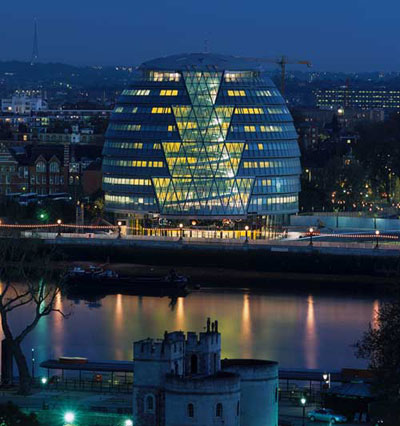Perfect buildings: the maths of modern architecture
The London City Hall
Architecture has in the past done great things for geometry. Together with the need to measure the land they lived on, it was people's need to build their buildings that caused them to first investigate the theory of form and shape. But today, 4500 years after the great pyramids were built in Egypt, what can mathematics do for architecture? At last year's Bridges conference, which explored the connections between maths and art and design, Plus met up with two architects of the Foster + Partners Specialist Modelling Group, Brady Peters and Xavier De Kestelier, to cast a mathematical eye over their work.

The London City Hall on the river Thames. Note the giant helical
stair case inside. Image © Foster + Partners.
stair case inside. Image © Foster + Partners.
Foster + Partners is an internationally renowned studio for architecture led by Norman Foster and a group of senior partners. It has created landmarks like 30 St Mary Axe in London (also known as the Gherkin), London City Hall and the Great Court at the British Museum. Ongoing projects include one of the biggest construction projects on the planet, Beijing International Airport, as well as the courtyard of the Smithsonian Institution in Washington DC and the new Wembley Stadium in London.
Many of Foster + Partners' projects have one thing in common: they are huge. This means maximal impact on their environment and its people. Designing such enormities is a delicate balancing act. A building not only needs to be structurally sound and aesthetically pleasing, it also has to comply with planning regulations, bow to budget constraints, optimally fit its purpose and maximise energy efficiency. The design process boils down to a complex optimisation problem. It's in the way this problem is solved that modern architecture differs most from that of the ancient Egyptians: advanced digital tools can analyse and integrate the bewildering array of constraints to find optimal solutions. Maths describes the shapes of the structures to be built, the physical features that have to be understood and, as the language of computers, forms the basis for every step of the modelling process.
https://plus.maths.org/content/perfect-buildings-maths-modern-architecture
No comments:
Post a Comment